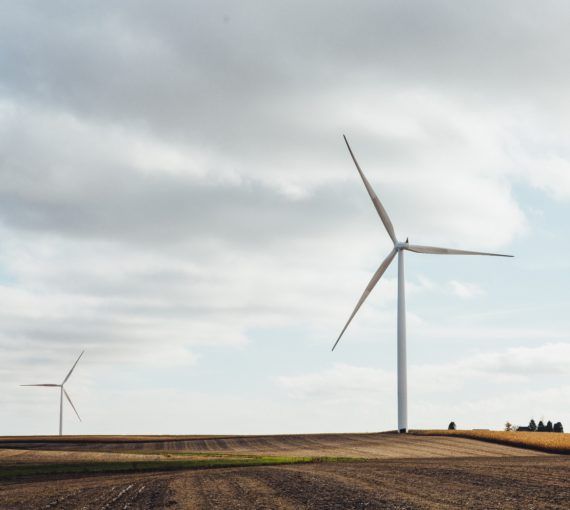
The benefits of shifting to reliable energy efficiency, cleaner sources and more interconnected systems are obvious, from reduced pollution and improved health to better employment opportunities and more stable economies. (Photo: Aliko Sunawang via Unsplash)
Canada could be a clean electricity powerhouse by 2035 — without building more large hydro dams or relying on expensive and sometimes unproven and dangerous technologies like nuclear or fossil gas with carbon capture and storage.
New David Suzuki Foundation modelling research — the first of its kind in Canada — finds we could affordably and quickly shift from fossil fuels to reliable 100 per cent emissions-free electricity using mainly wind and solar, existing hydro, energy efficiency, batteries and other energy storage technologies and grid improvements, including connecting grids between provinces. The transition would help Canada achieve its global climate commitments, create tens of thousands of new jobs and meet the growing demand for electricity.
Not only is this possible, the study notes that the underlying analysis was cautious: “The modelling did not consider a range of additional technologies and approaches, such as demand response, distributed renewables and emerging storage technologies that are likely to lead to increased efficiencies and further reductions in costs when moving to a zero-emissions electricity system.”
It did, however, account for increased demand from extensive electrification in transportation, buildings and industry as fossil fuels are swapped out.
The transition would help Canada achieve its global climate commitments, create tens of thousands of new jobs and meet the growing demand for electricity.
The report, “Shifting Power: Zero-Emissions Electricity Across Canada by 2035,” shows that the country is already in a good position, “with favourable wind and solar resources, a mature renewable electricity industry and momentum toward an emissions-free electricity system.” Alberta and Saskatchewan, in particular, have abundant wind and solar resources and opportunities to become renewable energy superpowers.
Between 2025 and 2050, the ambitious shift to clean electricity would also create at least 75,000 jobs a year in construction, operation and maintenance of new wind, solar and transmission lines alone — far more if wind turbines and solar panels were manufactured in Canada, and if induced jobs supported by the broader electricity sector are included.
Reliable renewable energy deployment at the scale the report outlined has been proven possible by other countries that have stepped up their efforts, partly in response to the accelerating climate crisis but also to Russia’s invasion of Ukraine, which has put a glaring spotlight on the geopolitical ramifications of fossil fuel dependency.
the ambitious shift to clean electricity would also create at least 75,000 jobs a year in construction, operation and maintenance of new wind, solar and transmission lines alone
For example, the report notes Germany had installed 28,000 onshore wind turbines by early 2022, reaching a total wind capacity of about 56 gigawatts, and expects to add 10 GW of wind annually by 2025 — equivalent to the deployment rate in scenarios the report evaluated. The European Union was expected to add 300,000 megawatts of renewable electricity between 2021 and 2026, but released an even more ambitious plan in light of Russia’s invasion.
Because all energy projects are located on Indigenous lands, the Foundation commissioned a companion study by Neegan Burnside and Dean Jacobs, “Decarbonizing Electricity and Decolonizing Power: Voices, Insights and Priorities from Indigenous Clean Energy Leaders,” which sets out six principles for upholding Indigenous rights and ensuring Indigenous communities benefit from a transition to emissions-free electricity. These are included in the main report’s recommendations.
There’s no excuse to delay, to continue building fossil fuel infrastructure and burning polluting, climate-altering fuels. We’re already seeing increasing heat domes, floods, droughts, water shortages, refugees fleeing inhospitable climates, decimation and extinction of plants and animals — and all will rapidly worsen if we don’t change course now.
There’s no excuse to delay, to continue building fossil fuel infrastructure and burning polluting, climate-altering fuels.
It’s appalling that governments feel compelled to compromise with those who argue we need to build more pipelines, dig up more bitumen, frack more landscapes and burn more coal, oil and gas, all for the sake of short-term, illusory economic gain. The costs of failing to act will be far greater than acting now. Scientists have been warning for decades that it’s time to change. Meanwhile, the most profitable industry in history and its supporters keep saying we can’t shift overnight, while sowing doubt about the science, lobbying behind closed doors and continuing to expand.
The choice is clear. The solutions are here. All that stands in the way is a cowardly lack of political will and a widespread belief that current “growth” economics and industry profits are more important than our own future and survival.
The benefits of shifting to reliable energy efficiency, cleaner sources and more interconnected systems are obvious, from reduced pollution and improved health to better employment opportunities and more stable economies. Let’s get on with it!



